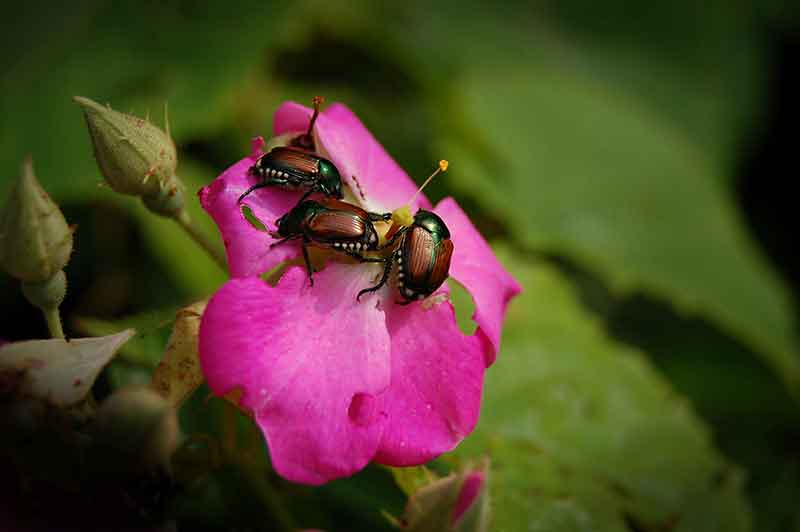Everything You Need to Know About Japanese Beetles
Few garden pests match the destructive power of Japanese beetles. In their mature form, they decimate gardens, leaving skeletonized leaves and weakened plants behind. In their immature stage, when they're commonly called grubs, they feast on tender grassroots, leaving brown, dying lawns in their wake. Controlling these invasive pests requires action during both stages. Understanding where Japanese beetles came from and where they're headed can help you take back the upper hand.
Century-Long Invasion
As their name suggests, Japanese beetles aren't native to the United States. First discovered in the U.S. at a New Jersey plant nursery in 1916,1 these pests found the U.S. climate and plant life to their liking. In their native country of Japan, natural enemies keep beetle numbers in proper balance. But in the U.S., those native Japanese predators aren't around to keep things in check. The U.S. Department of Agriculture reports that Japanese beetles were fully or partially established in more than 70 percent of the contiguous United States by January 2015, and they're now the country's most widespread turf-grass pests.1 Known to feed on approximately 300 species of plants, they impact everything from home gardens to major agricultural crops.4 No area of the country is free from their threat.2
Life Cycle Lessons
Japanese beetle damage is magnified because destruction occurs during multiple life stages. The first signs usually appear when mature beetles emerge from the ground in late spring to midsummer, often flying in from nearby areas and targeting stressed plants. About 1/2 inch long, these eye-catching pests have shiny, bronze wings and metallic green bodies with white, dot-like tufts of hair along their sides and rear. Beautiful garden roses and other beetle favorites are soon left with skeleton-like leaves and blossoms.

Adult beetles live 30 to 45 days and feed voraciously.4 They tend to gather to feed and lay eggs. During a two- to three-week period, female beetles repeatedly tunnel a few inches into the ground and lay up to 60 eggs each.3 Areas of healthy, sunny, well-irrigated and well-maintained lawn grasses are prime targets.
Japanese beetle eggs hatch during midsummer. The immature larvae, or grubs, stay close to the soil's surface and feed on grass roots. The grubs pass through several stages during growth, each one more damaging than the first. By the final stage, the plump, semi-transparent larvae measure about 1 inch long. Damage shows up in mid-to-late summer, as random lawn patches turn brown and die. The rootless turf rolls back easily, like a loose household rug, exposing grubs curled into a classic "C" shape.
As cool fall temps arrive, grubs move deeper into the soil, where they're protected from winter extremes — and efficient treatment. When spring returns, grubs move back toward the soil surface and feed until late spring. Then they change into a non-feeding stage called pupae. Mature beetles emerge in about two weeks, and the destructive cycle starts over again.3

Beetle Banishment
Controlling Japanese beetles involves treating the separate life stages. Proper products and timing strike the beetles and their larvae at their most vulnerable. Pesticides with proven beetle-fighting ingredients, such as those in Sevin® garden insecticides, provide effective control of Japanese beetles in the adult stage and as grubs.
- For mature beetles —Take a proactive approach with Sevin Insect Killer Ready To Use2, ideal for spot treatments, to kill Japanese beetles on contact. For larger treatment areas, turn to Sevin Insect Killer Concentrate or Sevin insect Killer Ready To Spray to kill Japanese beetles by contact and keep killing these pests for up to three months. Follow label instructions for your chosen product, including time allowed between application and edible harvests. When using any pesticides on edibles, always check the label for both the pest and the plant to get your pre-harvest interval (PHI) between treatment and harvest right.
- For grubs — Get maximum impact by treating in mid-to-late summer, when grubs are newly hatched, small and actively feeding near the surface. Apply Sevin Insect Killer Lawn Granules according to label instructions, and water well to release treatment into the soil where grubs dwell. Treat again in early spring, when overwintering grubs move back near the surface, before they pupate and emerge in beetle form. Check the label for PHIs on any edibles in your landscape. These granules kill Japanese beetles and their grubs by contact. Then they continue protecting your landscape for up to three months.
Proper treatment and timing helps stem the tide of Japanese beetles in your garden and across the United States. With effective Japanese beetle control from GardenTech® brands and Sevin® insecticides, you can take on these troublesome invasive pests and win.
Always read product labels thoroughly and follow instructions, including guidelines for pre-harvest intervals (PHI) and application frequency.
GardenTech is a registered trademark of Gulfstream Home & Garden, Inc.
Sevin is a registered trademark of Tessenderlo Kerley, Inc.
Sources:
1. U.S. Department of Agriculture Animal and Plant Health Inspection Service, “Managing the Japanese Beetle: A Homeowner's Handbook,", U.S. Department of Agriculture, August 2015.
2. U.S. Department of Agriculture Animal and Plant Health Inspection Service, “Japanese Beetle Predicted Development Stages," U.S. Department of Agriculture, July 2015.
3. New York State Integrated Pest Management Program, "Grubs in Your Lawn? A Guide for Lawn Care Professionals and Homeowners, Cornell University.
4. M.F. Potter, D.A. Potter and L.H. Townsend, “Japanese Beetles in the Urban Landscape,"University of Kentucky College of Agriculture, January 2006.
Get Monthly Gardening Advice!





